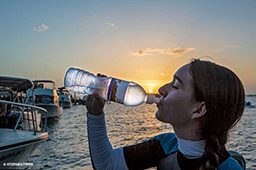Q: I am planning to participate in Florida’s lobster mini season (sport season) at the end of July, but it seems that every year there are reports of diver deaths during these two days. Why?
Lobster mini season is an annual pastime for the Florida diving community, but reports of diver deaths have raised concerns. The two-day event is an opportunity for sport divers to harvest spiny lobsters before commercial operations place traps during the regular season, which begins one to two weeks later on Aug. 6. In some areas, twice as many lobsters can be legally harvested during mini season as during the regular season. The short period combined with the increased bag limit has led to the emergence of a culture with strong competitive elements. For many participants, harvesting for sustenance tends to be subsidiary. With kickoff at midnight in areas that allow night diving, the event can vaguely resemble a marathon with the “winner” being the diver with the most impressive harvest after 48 hours.

Like other sports, scuba diving requires focus, mastery achieved through regular practice and maintenance of good physical fitness and general health. An encompassing perception of competition and thrill combined with the challenges unique to harvesting can distract divers from safety fundamentals. Prior to participation, it is vital that divers be proficient, especially given the intricacies inherent to harvesting. This type of diving is objective-based, which makes it different from most recreational diving. Managing equipment such as tickle sticks, snares and catch bags contributes to task loading, an increase in responsibilities that leads to a greater risk for error. Additionally, night diving is popular in some areas because of the midnight start, and it, too, requires special equipment and skills. Increased boat traffic is an additional concern for divers.
Fatalities and numerous dive accidents occur every mini season. During the 2014 mini season the DAN Emergency Hotline received a large number of calls reporting accidents that resulted in pulmonary barotrauma. For example, a newly certified diver participating in his first mini season complained of chest pain, sore throat and shortness of breath upon surfacing. He was taken to the local emergency department and diagnosed with extensive pneumomediastinum (air in the tissues around the heart). While the diver could not pinpoint a clear event leading to the injury, there are several ways it can occur.
Gas expands in the alveoli (air sacs) of the lungs during ascent. If breath-holding (or coughing or hiccupping) occurs during ascent, overinflation of the alveoli can occur, potentially causing pneumothorax (lung collapse), pneumomediastinum, subcutaneous emphysema (air beneath the skin) or arterial gas embolism (air in the arteries). Managing additional equipment and harvested lobsters can create buoyancy control challenges. To compensate for being overweighted, some divers may hold a greater volume of air in their lungs, which can increase the risk for pulmonary overinflation, particularly on ascent.
The spectacle of lobster mini season can be intoxicating, but with some preparation divers can minimize their risk for injury. When getting ready for mini season, think of it as a marathon: Begin preparing well in advance of the event by practicing consistently, building technique and refining skill. Prepare and plan for the possibility of adverse events. Focus on the goal, but know when to quit if needed to avoid injury. There will always be more marathons to run and more lobster mini seasons to dive.
— Stefanie D. Martina
Q: If 1.5 gallons of water is considered too much to drink (From the Medical Line, Fall 2014), what is your recommendation? Would it not depend on the environment and activity? When I worked as a river guide rowing the Grand Canyon, we would easily drink more than a gallon of water during the day.
Optimal hydration is a vexing topic — easy to talk about in theory but very difficult to pin down with numbers. Dehydration, often prompted by inadequate fluid intake (hypohydration), will result in depressed fluid volume and increased blood concentration, which, in turn, lead to reduced sweat rate, increased heat storage and decreased central venous pressure. Ultimately, cardiovascular capability, aerobic exercise capacity and the ability to tolerate heat strain would all be impaired, broadly compromising both physical and cognitive performance.
Excessive fluid intake (hyperhydration), conversely, can dilute the normal body water balance. Extreme cases can result in hyponatremia, a condition marked by depressed sodium concentration in the blood. Symptoms can include headache, nausea, vomiting, lethargy, impaired consciousness and, in extreme cases, death.

Body water is gained by fluid intake, some food intake and metabolic production. While the ingredients of some drinks act as diuretics, notably caffeine and alcohol, these are often delivered with large enough fluid volumes that the net impact will be an effective increase in body water volume. While alcohol ingestion is discouraged for other reasons, beer — particularly low-alcohol beer — has been shown to be an effective rehydrating agent. Electrolyte drinks replenish salts and other elements important for physiological function along with the water, reducing the likelihood of hyponatremia (abnormally low sodium levels in the blood) even with substantial fluid intake.
Evaluating state of hydration based on urine color seems logical but is not always valid. Urine production throughout the day is heavily influenced by short-term events. For example, being acutely chilled will cause vasoconstriction and concentration of blood in the core. More core blood means more blood returning to the heart. The heart responds to this increased volume by beating harder and altering hormone release to stimulate fluid elimination in the kidney. This, in turn, will result in a clear urine sample regardless of the underlying state of hydration. Similarly, very dark urine does not necessarily mean that a person is dehydrated, since the urine volume is freely sacrificed to protect plasma volume.
The challenges of short-term variability can largely be avoided by focusing on the first sample of urine produced after waking from a comfortable full-length sleep period. The normal adult production rate of around two or three fluid ounces per hour (one milliliter per kilogram of body mass per hour). Low production rates indicate inadequate kidney function, possibly due to insufficient fluid intake. The color should be a pale yellow, but be aware that some foods and medications (over the counter as well as prescription) can affect normal color. Assuming no interactions with food or medication, consistently rich or darker yellows suggest that increased fluid intake may be warranted. Consistently colorless urine could indicate a pattern of excessive hydration.
Thirst is an unreliable indicator of one’s state of hydration. Consciously drinking regularly and checking the first waking urine sample probably provides a better foundation. Given differences in body size, fluid and food intake patterns and environmental pressures among individuals, it is often inappropriate to recommend arbitrary volumes of fluid to be ingested. In the real world for real people, the guidance could range from far too little to far too much.
As an interesting side note, the often-quoted advice to drink eight 8-ounce glasses of water per day was not based on any science. The recommendation was reportedly adopted as a simple promotional campaign for the community when inadequate fluid intake was felt to be a critical issue.
While there is no simple answer to your question, one can apply the preceding information practically. If a person does not regularly develop headaches, feels generally good and has fairly pale, clear yellow urine on the first waking sample, then current fluid intake patterns may be reasonable. If the first waking sample is transparent and the person feels lethargic or has other symptoms that could be associated with hyponatremia, reducing the fluid intake may be a useful test to see if the sense of wellness improves. Eating a well-balanced diet will help ensure adequate electrolyte foundations. Periods of high fluid stress, such as exercise in hot and humid conditions, can be met with a combination of plain water and electrolyte drinks, but realize that the calories in most electrolyte drinks may be more than necessary. Most important, any frank concerns should be discussed with a health-care professional.
— Neal W. Pollock, Ph.D.
© Alert Diver — Q2 Spring 2015